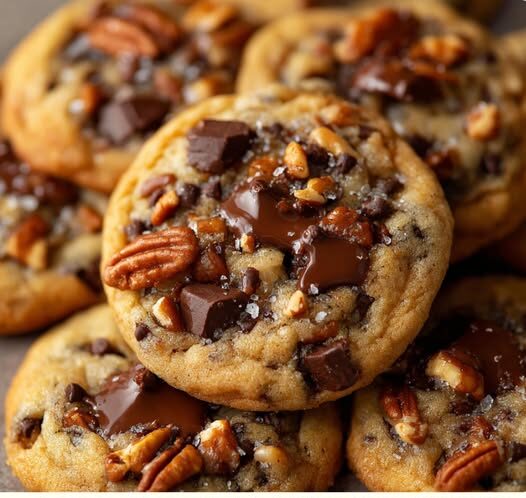Turtle Pudding Cookies are my idea of the perfect indulgent cookie: soft, chewy, and packed with pockets of chocolate, caramel, and crunchy pecans. They take everything I love about classic turtle candies and tuck it into a bakery‑style cookie that stays tender for days thanks to instant pudding in the dough. Every bite has a mix of gooey chocolate, buttery caramel, and toasty nuts that feels completely over the top in the best way.
I love making Turtle Pudding Cookies when I want something a little fancier than a basic chocolate chip cookie but just as easy to pull together. The base starts with your flour, baking soda, and salt, then gets enriched with melted or softened butter, sugars, vanilla pudding mix, and eggs. From there, I load the dough with chocolate chips or chunks, chopped pecans, and caramel bits. A short chill and a quick bake give you thick, bakery‑style cookies with soft centers and slightly crisp edges.
Ingredients for Turtle Pudding Cookies
You gave the base dry ingredients; here’s the full list in that style, scaled to match a classic pudding‑cookie batch.
Dry ingredients:
- 2 1/2 cups all‑purpose flour
- 1 teaspoon baking soda
- 1/2 teaspoon salt
- 1 (3.4‑ounce) box instant vanilla pudding mix (dry)
Wet ingredients:
- 3/4 cup unsalted butter, melted and slightly cooled
- 1 cup packed brown sugar
- 1/2 cup granulated sugar
- 2 large eggs
- 1 tablespoon vanilla extract
Turtle mix‑ins:
- 3/4 cup semi‑sweet chocolate chips or chunks
- 3/4 cup caramel bits or chopped soft caramels
- 3/4 cup roughly chopped pecan halves, plus extra for topping if you like
How I Make Turtle Pudding Cookies
1. Whisk the dry ingredients
I start by whisking together the flour, baking soda, salt, and dry vanilla pudding mix in a medium bowl. The pudding powder blends with the flour and helps keep the cookies ultra‑soft and chewy after baking.
2. Mix the butter and sugars
In a larger bowl, I combine the melted, slightly cooled butter with the brown sugar and granulated sugar. I beat or whisk until the mixture looks thick and glossy. Using melted butter (rather than fully creamed) gives the cookies a denser, chewier texture, which works perfectly with all the turtle mix‑ins.
3. Add eggs and vanilla
Next, I beat in the eggs one at a time, then mix in the vanilla extract. I keep whisking until the mixture turns smooth and a bit lighter in color, which means everything is fully combined.
4. Combine wet and dry
I add the dry ingredient mixture to the wet ingredients and stir with a spatula just until no dry streaks of flour remain. The dough will be fairly thick. Pudding cookie doughs can look a little stickier than regular cookie dough, but that’s what gives them their soft texture once baked.
5. Fold in chocolate, caramel, and pecans
I pour in the chocolate chips, caramel bits, and chopped pecans, then fold them gently into the dough until they’re evenly distributed. For extra visual appeal, I like to reserve a small handful of each to press onto the tops of the cookies right before baking.
6. Chill the dough
To keep the cookies thick and prevent too much spreading, I cover the bowl and chill the dough for at least 1–2 hours, or even overnight if I’m planning ahead. Chilling lets the flour hydrate and the butter firm back up, which leads to taller, chewier Turtle Pudding Cookies.
7. Scoop and bake
When I’m ready to bake, I heat the oven to 325–350°F (depending on my oven) and line baking sheets with parchment. I scoop about 2–3 tablespoons of dough per cookie, rolling each portion into a ball. I place them a couple of inches apart on the sheet, then gently press a few extra chocolate chunks and pecan pieces onto the top of each dough ball, and tuck a couple more caramel bits on the surface.
I bake the cookies for 10–12 minutes, just until the edges are set and lightly golden but the centers still look soft and slightly underdone. They’ll continue to firm up on the hot baking sheet. Overbaking can make the caramel too hard and the cookies less chewy, so I err on the side of slightly under.
8. Cool and finish
After removing the sheet from the oven, I let the cookies cool on the pan for about 5 minutes to set up, then transfer them carefully to a rack. If any caramel has pooled, I nudge it back toward the cookie with a spatula while it’s still warm. Once cooled, the cookies are soft, thick, and filled with gooey pockets of chocolate and caramel plus toasty pecans on top.
Continue to the next page to reveal more tips and tricks

